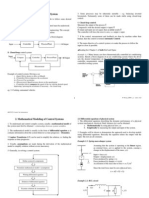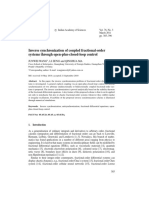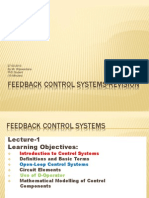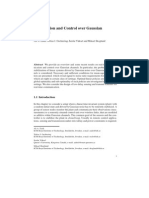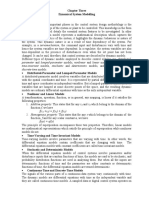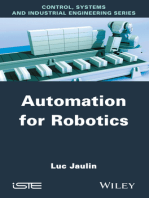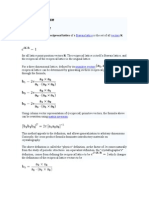CDS 110b Norms of Signals and Systems
CDS 110b Norms of Signals and Systems
Uploaded by
Satyavir YadavCopyright:
Available Formats
CDS 110b Norms of Signals and Systems
CDS 110b Norms of Signals and Systems
Uploaded by
Satyavir YadavOriginal Description:
Original Title
Copyright
Available Formats
Share this document
Did you find this document useful?
Is this content inappropriate?
Copyright:
Available Formats
CDS 110b Norms of Signals and Systems
CDS 110b Norms of Signals and Systems
Uploaded by
Satyavir YadavCopyright:
Available Formats
CALIFORNIA INSTITUTE OF TECHNOLOGY
Control and Dynamical Systems
CDS 110b
R. M. Murray Norms of Signals and Systems 13 February 2006
In this set of lectures we introduce the concept of the norm of a (linear) system and
show how this can be used to specify stability and performance measures.
Reading:
DFT, Chapters 2 and 3
1 Introduction
One of the key uses of feedback is to provide robustness to uncertainty. We have already
seen several examples of this in the previous chapters, from tracking a reference signal whose
evolution is not known ahead of time, to rejecting disturbances that might aect the process
or our measurements of it. In this chapter we generalize the classes of uncertainty that we
can analyze to include uncertainty in the process that we are trying to control.
Robustness to process variations is the ability of a closed loop system to be insensitive to
component variations that make up the system. It is one of the most useful properties of
feedback and is what make it possible to design feedback systems based on strongly simplied
models.
One of the key issues in studying robustness is to describe variations in system dynamics.
Using state space representations for a system, uncertainty can be captured by varying the
parameters of a system (e.g., the elements of the A, B, C and D matrices). There are
however many variations that are not captured by such an approach. For example, some
dynamic phenomena may have been neglected during the modeling stage to keep the the
size of the model tractable. These unmodeled dynamics cannot be accounted for by simply
modifying the parameters of the simplied system. Similarly, there may also be small time
delays that have been neglected in a model, in part because these are dicult to analyze
using ODEs.
As an example of this type of uncertainty, consider the speed controller that has been dis-
cussed throughout CDS 110a. We have designed several dierent controllers for this system
using a model that was derived in Chapter 2 of AM05. The original model considered the dy-
namics of the forward motion of the vehicle and the torque characteristics of the engine and
transmission. It did not, however, include a detailed model of the engine dynamics (whose
F C P
1
r
e u v
d
w
n
y
Figure 1: Block diagram of a basic feedback loop.
combustion processes are extremely complex), nor the slight delays that can occur in modern
electronically controlled engines (due to the processing time of the embedded computers).
Rather than try to include all of these details in our model, and how they change over time,
we can instead try to show that the controllers that we have designed using our simplied
models are robust with respect to the unmodeled dynamics. Under the assumption that the
dynamics that we initially ignored are small compared with the dominant dynamics of the
system, we expect that our controllers will work when implemented on the full system.
Transfer functions provide a natural way of modeling these types of uncertainty (and many
others). The basic idea is to model the unmodeled dynamics by including a transfer func-
tion in the system desription whose frequency response is bounded, but otherwise unspecied.
So, for example, we might model the engine dynamics in the speed control example as a sys-
tem that very quickly provides the torque that is requested through the throttle, giving a
small deviation from the simplied model, which assumed the torque response was instan-
taneous. This technique can also be used in many instances to model parameter variations,
allowing a quite general approach to uncertainty management. One limitation of the tools
we present here is that they are usually restricted to linear systems, although some nonlinear
extensions have been developed.
A block diagram representation of this approach is shown below: In this gure, the block
represents the unmodeled dynamics of the system and we think of as small (in a sense
to be made precise later). Our goal is to design a controller C such that the closed loop
performance of the system satises a given specication for any M. We say that such
a controller is robust with respect to the (bounded) perturbation . In order to make these
concepts precise, we dene the norms of signals and systems.
2 Norms of Signals
Denition 1. A set V is a linear (vector) space over R if we can dene operations of addition
(of vectors) and multiplication (by scalars) such that for every x, y V and , R we
2
have
x +y V (x +y) = x +y V
and there exists a zero element
0 V such that
0 = xx = 0 x (where 0 is the real number
zero).
Examples:
1. V = R
n
2. C
n
[t
0
, t
1
] = the space of continous functions mapping the interval [t
0
, t
1
] to R
n
.
3. P
n
(, ) = the set of piecewise continous functions on (, ) taking values in
R
n
.
These last two examples are innite dimensional, in the sense that there is no nite basis
for the space.
Denition 2. Let V be a vector space over R. A mapping : V R
n
is a norm if it
satises:
1. x 0 for all x V
2. x = 0 if and only if x = 0
3. x = || x for all x V and R
4. x +y x +y (triangle inequality)
The denitions are correct even if V is innite dimensional. For example, if we take
C(, ) = {x : (, ) R, continuous}, then the zero element is the zero func-
tion and scaling and addition are done pointwise in time:
(u +v)(t) = u(t) +v(t) (u)(t) = u(t)
Examples of norms:
Name V = R
n
V = {u : (, ) R}
1-norm x
1
=
n
i=1
|x
i
| u
1
=
_
|u(t)| dt
2-norm x
2
=
_
n
i=1
|x
i
|
2
u
2
=
_
_
|u(t)|
2
dt
_
1/2
p-norm x
p
=
p
_
n
i=1
|x
i
|
p
u
p
=
_
_
|u(t)|
p
dt
_
1/p
-norm x
= max
i
|x
i
| u
= sup
t
|u(t)|
3
The operation sup is the least upper bound of a function.
Example: 2 norm on C(, )
1. u
2
=
_
_
|u(t)|
2
dt
_
1/2
> p
2.
u
2
= 0 =
_
|u(t)|
2
= 0
= u(t) = 0 on any interval
= u(t) = 0 for all t (by continuity) = u = 0
3. u
2
=
_
_
|u(t)|
2
dt
_
1/2
= u
2
4. Triangle inequality: u +v
2
u
2
+v
2
Proof: Exercise. Use the fact that |u(t) +v(t)| |u(t)| +|v(t)|.
Denition 3. A normed linear space V is a linear (vector) space V equipped with a norm
.
Examples:
L
1
V = P(, )
1
L
2
V = P(, )
2
L
V = P(, )
3 Linear Mappings and Induced Norms
Let V and W be linear spaces over R.
Denition 4. A mapping A : V W is a linear map if
A(
1
v
1
+
2
v
2
) =
1
Av
1
+
2
Av
2
for all v
1
, v
2
V and
1
,
2
R.
Examples:
1. The set of n n matrices are a linear map from R
n
to R
n
using the usual rules of
multiplying a vector by a matrix.
2. Let V = P[0, 1] and W = R. Then the operator given by
Av =
_
1
0
v(t) dt
is a linear mapping from V to W.
4
3. Let V = P[0, ] and W = P[0, ]. Then the operator given by
w(t) =
_
t
0
e
a(t)
v() d
is a linear mapping from V to W.
Denition 5. Let V be a vector space with norm
a
and W be a vector space with norm
b
. Then the induced norm
a,b
of A : V W is given by
A
a,b
= sup
va1
Avb
Example: matrix norms
V = R
n
W = R
n
A : V W
v
2
=
v
T
v w
2
=
w
T
w A
2,2
=
_
max
(A
T
A)
4 Norms of Systems
u P y y(t) = Ce
At
x(0)
. .
Assume zero
+
_
t
0
Ce
A(t)
Bu() d
. .
Linear map
Q: what is the induced norm of the system P, thought of as an input/output mapping of
signals?
A: Depnds on the norm of the signals
Theorem 1. Let be a stable system with state space representation (A, B, C, 0), transfer
function H(s) = C(sI A)
1
B. Then the following table gives the input/output norm of
u
2
=
_
_
u
2
(t)dt
_
1/2
u
= sup
t
|u(t)|
y
2
sup
|H(j)|
y
1
2
_
_
|H(j)|
2
d
_
1/2 _
|Ce
At
B|dt
If we let h(t) = Ce
At
B be the impulse response for the system and dene H
= sup
|H(j|
and H
2
=
1
2
_
_
|H(j)|
2
d
_
1/2
then
u
2
u
y
2
H
H
2
h
1
5
These dene the three major approaches to linear control:
H
= L
2
to L
2
H
2
= L
2
to L
l
1
= L
to L
Remarks:
1. These system norms only work for linear systems since otherwise looking at u 1
is not sucient.
2. Can extend to nonlinear systems if you constrain the inputs to be u U = {u : u
2
1}. Get nonlinear H
this way.
3. The focus of DFT is H
control = L
2
L
2
induced norm. Think of this as the
energy of the input (or noise) to the energy of the output.
4. Proofs of these norms are given in the book. OK to skip, but here is the idea (for H
):
Let y(s) =
_
y(t)e
st
dt (Laplace transform)
Can show that y
2
2
=
1
2
_
| y(j)|
2
d (Parsevals theorem)
Can also show that y(s) = H(s)u(s) (convolution multiplication)
y
2
2
= y
2
2
=
1
2
_
H(j)|
2
| u(j)|
2
d
H
2
1
2
_
| u(j)|
2
d = H
2
u
2
2
= y
2
H
u
2
.
To complete the proof, show that there exists u(t) that achieves this bound so that
max
u
2
1
y
2
= max
u
2
1
Hu
2
= H
5 Stability and Performance
We now show how to write conditions for stability and performance in terms of the norms
of systems. We assume that the process and controller are LIT systems. In addition, we will
make the simplifying assumption that the disturbances and noise enter linearly at the same
point as the inputs and outputs of the process (as shown in Figure 1 on page 2).
Remarks:
6
1. H(s) is the Laplace transform of the impulse response h(t)
2. H(s) is rational if the system is nite dimensional
H(s) =
n(s)
d(s)
n(s), d(s) polynomials
3. Standard terms:
H(s) is stable if it is analytic in the closed right half plane (i.e., no RHP poles)
H(s) is proper if H(j) is nite (deg d deg n)
H(s) is strictly proper if H(j) 0 (deg d > deg n)
H(s) is biproper if H(s) and H
1
(s) are proper (deg d = deg n)
4. Parsevals theorem
1
2
_
|H(j)|
2
d =
_
|h(t)|
2
d
Stability
Proposition 2. If a transfer function is stable then bounded inputs yield bound outputs.
Proof. Assume that H is stable. Then h
1
is bounded and hence y
h
1
u
=
bounded inputs yield bounded outputs. The converse is also true.
Denition 6. A feedback interconnection is internally stable if the closed loop transfer
function from any input to any other signal is stable.
Remarks:
1. Internal stability = signals inside the feedback loop remain bounded. Example of
something that is not internally stable:
x3
1
s1
s1
(s+1)
2
r
n
d
u y H
yr
=
PC
1 +PC
=
1
(s + 1)
2
(work out)
H
ur
=
C
1 +PC
=
(s + 1)
2
(s 1)(s + 1)
2
(unstable)
2. Consider the basic feedback loop
7
C P
F
r
n
d
u y x
2
x
3
x
3
v
_
_
x
1
x
2
x
3
_
_
=
1
1 +PCF
_
_
1 PF F
C 1 CF
PC P 1
_
_
_
_
r
d
n
_
_
Internally stable all 9 transfer functions are stable (other signals are simple
linear combinations, eg y = x
3
n, etc).
3. If F = 1, can reduce the number of transfer functions which need to be checked
(homework).
If P, C and F are rational transfer functions, we can write them as
P =
n
P
d
P
C =
n
C
d
C
F =
n
F
d
F
where each n
X
and d
X
re coprime polynomials (no common zeros).
Note that the closed loop poles of the basic feedback loop are given by the zeros of n
P
n
C
n
F
+
d
P
d
C
d
F
= (s) = characteristic polynomial.
Theorem 3. The basic feedback loop is internally stable if and only if there are no zeros of
(s) = n
P
n
C
n
F
+d
P
d
C
d
F
in the closed right half plane.
Proof. Consider the case when F = 1 (for simplicity). Can show
_
_
x
1
x
2
x
3
_
_
=
1
n
P
n
C
+d
P
d
C
_
_
d
P
d
C
n
P
d
C
d
P
d
C
d
P
n
C
d
P
d
C
d
P
n
C
n
P
n
C
n
P
d
C
d
P
d
C
_
_
_
_
r
d
n
_
_
and the poles are all contained in the common factor 1/(n
P
n
C
+d
P
d
C
).
Theorem 4. The basic feedback loop is internally stable if and only if the following conditions
hold:
1. 1 +PCF has no zeros in the right half plane (Re s 0)
2. There are no pole zero cancellations in Re s 0 when PCF is formed
Proof. See DFT
8
Performance
We choose our performance goal to try to get good tracking for a set of signals.
Sensitivity function: S =
1
1 +PC
= H
er
We would like to keep this transfer function small ( = good tracking)
Assume internal stability = S is stable and proper
Assume P is strickly proper = S(j) = 1 = bad tracking at high frequency.
Complementary sensitivity function: T ==
PC
1 +PC
H
yr
Note that T is equal to H
du
= gives the transfer function between disturbances
and input
Would like to keep this transfer function small as well
Cant make both S and T small since
S +T =
1
1 +PC
+
PC
1 +PC
= 1 for all
= tradeo between input magnitude and tracking error.
Suppose we want performance to mean small error for unit sized inputs. Try
S
= tolerated error
= for r(t) = sin(t), |e(t)| .
Problem: S(j) = 1 = S
1 = cant make S arbitarily small.
Fix: Specify performance in terms of weighted sensitivity function.
W
1
S
1 when W
1
is small, allow larger errors.
9
W
1
1
|W
1
|
S should lie below W
1
1
good perf
dont
care
large error
Remarks:
1. Lots of ways of justifying why W
1
S
makes sense (L
2
-induced norm, etc). Big
reason: it works well.
2. Other possibilities:
_
e
u
_
=
_
PS S
T CS
_ _
d
n
_
S = sensitivity function
T = complementary sensitivity function
Can shoose any of these (or combination) for performance spec.
Nyquisti plot interpretation:
W
1
S
< 1
W
1
(j)
1 +L(j)
< 1
|W
1
(j)| < |1 +L(j)| 1 +|L(j)|
|W
1
|
1
The size of the disk at 1 changes size depending on frequency = |W
1
gives the distance
that we want to stay away from 1 (where we go unstable).
10
You might also like
- HHT Alpha MethodDocument22 pagesHHT Alpha MethodSasi Sudhahar ChinnasamyNo ratings yet
- Taylor Series in ChemistryDocument4 pagesTaylor Series in ChemistryAndreea DărîngăNo ratings yet
- Elementary Properties of Cyclotomic Polynomials by Yimin GeDocument8 pagesElementary Properties of Cyclotomic Polynomials by Yimin GeGary BlakeNo ratings yet
- Tute Exercises PDFDocument141 pagesTute Exercises PDFVivienneNo ratings yet
- Isolating The Variable - How To PROVE Your WorkDocument1 pageIsolating The Variable - How To PROVE Your WorkJulie Hill Reulbach100% (3)
- Averaging Oscillations With Small Fractional Damping and Delayed TermsDocument20 pagesAveraging Oscillations With Small Fractional Damping and Delayed TermsYogesh DanekarNo ratings yet
- Modeling and Simulation of Dynamic Systems: Lecture Notes of ME 862Document9 pagesModeling and Simulation of Dynamic Systems: Lecture Notes of ME 862RajrdbNo ratings yet
- A Performance Comparison of Robust Adaptive Controllers: Linear SystemsDocument26 pagesA Performance Comparison of Robust Adaptive Controllers: Linear SystemsNacer LabedNo ratings yet
- Path-Following For Non-Minimum Phase Systems Removes Performance LimitationsDocument6 pagesPath-Following For Non-Minimum Phase Systems Removes Performance LimitationsyuniervNo ratings yet
- HP-ppl06Document16 pagesHP-ppl06saidNo ratings yet
- An Adaptive High-Gain Observer For Nonlinear Systems: Nicolas Boizot, Eric Busvelle, Jean-Paul GauthierDocument8 pagesAn Adaptive High-Gain Observer For Nonlinear Systems: Nicolas Boizot, Eric Busvelle, Jean-Paul Gauthiertidjani73No ratings yet
- Analogue Realizations of Fractional-Order ControllersDocument16 pagesAnalogue Realizations of Fractional-Order Controllerstarunag72801No ratings yet
- HET312 NotesDocument41 pagesHET312 NotesTing SamuelNo ratings yet
- RevisedDocument6 pagesRevisedPaulina MarquezNo ratings yet
- Nu Taro ContinuousDocument23 pagesNu Taro ContinuousRavi KumarNo ratings yet
- Applsci 09 03606 v2Document14 pagesApplsci 09 03606 v2Jéssica FeitosaNo ratings yet
- FEEDLAB 02 - System ModelsDocument8 pagesFEEDLAB 02 - System ModelsAnonymous DHJ8C3oNo ratings yet
- Sampling and Sampled-Data SystemsDocument20 pagesSampling and Sampled-Data Systemsvineetverma0698No ratings yet
- Robust Pointwise Min-Norm Control of Distributed Systems With Fluid FlowDocument6 pagesRobust Pointwise Min-Norm Control of Distributed Systems With Fluid FlowdgsdfjkgdfjksnNo ratings yet
- Experiment-1: AIM: For The Given Train Model, Find The State Space ModelDocument26 pagesExperiment-1: AIM: For The Given Train Model, Find The State Space ModelIchigoNo ratings yet
- Project Report Molecular Dynamics CMSC6920Document4 pagesProject Report Molecular Dynamics CMSC6920Nasir DanialNo ratings yet
- Sliding Mode-: Modulation Control of A "Buck" ConverterDocument6 pagesSliding Mode-: Modulation Control of A "Buck" ConverterFarag AlargtNo ratings yet
- Introduction To System Modeling: Dynamic System Input U (T) Output y (T)Document19 pagesIntroduction To System Modeling: Dynamic System Input U (T) Output y (T)ettypasewangNo ratings yet
- Ieee CSL2021Document6 pagesIeee CSL2021Adriano Nogueira DrumondNo ratings yet
- Inverse Synchronization of Coupled Fractional-Order Systems Through Open-Plus-Closed-Loop ControlDocument12 pagesInverse Synchronization of Coupled Fractional-Order Systems Through Open-Plus-Closed-Loop Controllanoke9980No ratings yet
- Modeling of Dynamic SystemsmesinDocument19 pagesModeling of Dynamic SystemsmesinRifqi Bustanul FaozanNo ratings yet
- Lecture 3-Transfer Functions v2.0Document21 pagesLecture 3-Transfer Functions v2.0bayan.life14100% (1)
- Notes On ARIMA Modelling: Brian Borchers November 22, 2002Document19 pagesNotes On ARIMA Modelling: Brian Borchers November 22, 2002Daryl ChinNo ratings yet
- Ieee 1Document10 pagesIeee 1Andrei SteleaNo ratings yet
- Modern Control Theory and It'S ApplicationsDocument9 pagesModern Control Theory and It'S ApplicationsMohamed ShamseldeinNo ratings yet
- De SolveDocument52 pagesDe Solveoloyede_wole3741No ratings yet
- Waveform Relaxation Theory and PracticeDocument64 pagesWaveform Relaxation Theory and Practicelilypeng789No ratings yet
- Paper 31Document6 pagesPaper 31Daniel G Canton PuertoNo ratings yet
- Control Systems EngineeringDocument32 pagesControl Systems EngineeringSingappuli100% (2)
- 2005 - Control For Recycle Systems Based On A Discrete Time Model ApproximationDocument6 pages2005 - Control For Recycle Systems Based On A Discrete Time Model ApproximationademargcjuniorNo ratings yet
- Estimacion de ParametrosDocument13 pagesEstimacion de ParametrosCesar Augusto GarechNo ratings yet
- Oscillatory Motion Control of Hinged Body Using ControllerDocument8 pagesOscillatory Motion Control of Hinged Body Using ControlleresatjournalsNo ratings yet
- 11 Gain SchedulingDocument8 pages11 Gain Schedulingstathiss11No ratings yet
- Repetitive Control Systems: Old and New Ideas: George WEISSDocument16 pagesRepetitive Control Systems: Old and New Ideas: George WEISSSherif M. DabourNo ratings yet
- Oscillatory Motion Control of Hinged Body Using ControllerDocument8 pagesOscillatory Motion Control of Hinged Body Using ControllerInternational Journal of Research in Engineering and TechnologyNo ratings yet
- Delay-Dependent Robust H Control of Time-Delay Systems: M. Sun Y. JiaDocument9 pagesDelay-Dependent Robust H Control of Time-Delay Systems: M. Sun Y. JiainfodotzNo ratings yet
- Normalizar El ChuaDocument10 pagesNormalizar El ChuaantoniolflacoNo ratings yet
- Optimal Control of Stochastic Delay Equations and Time-Advanced Backward Stochastic Differential EquationsDocument25 pagesOptimal Control of Stochastic Delay Equations and Time-Advanced Backward Stochastic Differential EquationsIdirMahroucheNo ratings yet
- Stabilization and Control Over Gaussian NetworksDocument48 pagesStabilization and Control Over Gaussian NetworksFan ZhangNo ratings yet
- EE132 Lab1 OL Vs CLDocument3 pagesEE132 Lab1 OL Vs CLthinkberry22No ratings yet
- Motor Modeling and Position Control Lab Week 3: Closed Loop ControlDocument14 pagesMotor Modeling and Position Control Lab Week 3: Closed Loop ControlJanett TrujilloNo ratings yet
- Derivative-Free Model Reference Adaptive Control of A Generic Transport ModelDocument18 pagesDerivative-Free Model Reference Adaptive Control of A Generic Transport ModelKrisdannerNo ratings yet
- ENGM541 Lab5 Runge Kutta SimulinkstatespaceDocument5 pagesENGM541 Lab5 Runge Kutta SimulinkstatespaceAbiodun GbengaNo ratings yet
- Reference Signal Tracking Control of The Tora System: A Case Study of TP Model Transformation Based ControlDocument14 pagesReference Signal Tracking Control of The Tora System: A Case Study of TP Model Transformation Based ControlLuizNo ratings yet
- Week9 Model ConversionDocument24 pagesWeek9 Model ConversionAl AidenNo ratings yet
- Fractional Calculus Applications in Control SystemsDocument4 pagesFractional Calculus Applications in Control SystemsSanket KarnikNo ratings yet
- Moodle 3 - Dynamical System ModellingDocument28 pagesMoodle 3 - Dynamical System ModellingOloyede JeremiahNo ratings yet
- Regn_lect_7Document26 pagesRegn_lect_7Martha ReubenNo ratings yet
- Ellipsoid Based L - 2 Controller Design For LPV Systems With SaturaDocument12 pagesEllipsoid Based L - 2 Controller Design For LPV Systems With SaturaAhmet ÇelikNo ratings yet
- Discret HamzaouiDocument19 pagesDiscret HamzaouiPRED ROOMNo ratings yet
- Professor Bidyadhar Subudhi Dept. of Electrical Engineering National Institute of Technology, RourkelaDocument120 pagesProfessor Bidyadhar Subudhi Dept. of Electrical Engineering National Institute of Technology, RourkelaAhmet KılıçNo ratings yet
- On Approximate Dynamic Inversion and Proportional-Integral ControlDocument6 pagesOn Approximate Dynamic Inversion and Proportional-Integral ControlgaderiNo ratings yet
- Transfer Functions and Block Diagrams PDFDocument21 pagesTransfer Functions and Block Diagrams PDFJuliana NepembeNo ratings yet
- Discret IzationDocument18 pagesDiscret IzationsydofneeNo ratings yet
- Student Solutions Manual to Accompany Economic Dynamics in Discrete Time, second editionFrom EverandStudent Solutions Manual to Accompany Economic Dynamics in Discrete Time, second editionRating: 4.5 out of 5 stars4.5/5 (2)
- Nonlinear Control Feedback Linearization Sliding Mode ControlFrom EverandNonlinear Control Feedback Linearization Sliding Mode ControlNo ratings yet
- Some Modified Matrix Eigenvalue: E 2 (X), (A I) A (X) - (9) ) - A (A) O'i (A O'2 (A A, (A) 21 (A) 22 (A) 2, (A)Document17 pagesSome Modified Matrix Eigenvalue: E 2 (X), (A I) A (X) - (9) ) - A (A) O'i (A O'2 (A A, (A) 21 (A) 22 (A) 2, (A)Satyavir YadavNo ratings yet
- Pendulum SimulinkDocument10 pagesPendulum SimulinkSatyavir YadavNo ratings yet
- Concepts of Sliding Mode ControlDocument250 pagesConcepts of Sliding Mode ControlSatyavir YadavNo ratings yet
- Notes PhasePlane PDFDocument28 pagesNotes PhasePlane PDFSol NascimentoNo ratings yet
- A13v35n1 - Chua's CircuitDocument8 pagesA13v35n1 - Chua's CircuitS. ChavesNo ratings yet
- Diffrencial EquationDocument6 pagesDiffrencial Equationsinghaditya5569No ratings yet
- Graphic Arts 105 SyllabusDocument17 pagesGraphic Arts 105 SyllabusCristopher MirezNo ratings yet
- Exercises: (CF) ' (F+ G) ' F' + G' (FDocument5 pagesExercises: (CF) ' (F+ G) ' F' + G' (Frobertlin2006No ratings yet
- Huens Method Lake ModelDocument5 pagesHuens Method Lake ModelggNo ratings yet
- Lecture32 K-Means Clustering ExerciseDocument2 pagesLecture32 K-Means Clustering ExercisePavan KumarNo ratings yet
- Problems NTDocument3 pagesProblems NTChirag SinghalNo ratings yet
- Fig. B1 (B) : Determination of "W" DimensionDocument1 pageFig. B1 (B) : Determination of "W" DimensionCovjece Ne Ljuti SeNo ratings yet
- On HomotopyDocument21 pagesOn HomotopyDr. P.K.Sharma100% (1)
- Quantitative Analysis Technical TermsDocument4 pagesQuantitative Analysis Technical TermsMaireen Jamie BalibalosNo ratings yet
- 8FM0-01 As Core Pure Mathematics October 2020 Examination Paper PDF 1Document28 pages8FM0-01 As Core Pure Mathematics October 2020 Examination Paper PDF 1Rizan RazakNo ratings yet
- Convex Optimization 2 - Charalampos SalisDocument12 pagesConvex Optimization 2 - Charalampos SalisTrompa LompaNo ratings yet
- Absolute Value Equations and Inequalities ReviewDocument4 pagesAbsolute Value Equations and Inequalities ReviewMa NouNo ratings yet
- Elimination MethodDocument2 pagesElimination MethodGrace Leal Relado100% (1)
- The University of Lahore ProspectusDocument119 pagesThe University of Lahore Prospectuswaqasahmadz100% (1)
- Chapter 4 DeterminantsDocument3 pagesChapter 4 Determinantssraj68No ratings yet
- Brillouin ZonesDocument6 pagesBrillouin ZonesPavan Sharma0% (1)
- Gradshteyn and Ryzhik Table of Integrals PDFDocument3 pagesGradshteyn and Ryzhik Table of Integrals PDFMichelleNo ratings yet
- Introduction To Information Theory and CodingDocument46 pagesIntroduction To Information Theory and CodingGv RaviNo ratings yet
- BCA IV OT_UNIT IDocument18 pagesBCA IV OT_UNIT IAMIT JADHAVNo ratings yet
- Optimal Placement and Sizing of Dgs in Distribution Networks Using Dandelion Optimization Algorithm: Case Study of An Algerian Distribution NetworkDocument9 pagesOptimal Placement and Sizing of Dgs in Distribution Networks Using Dandelion Optimization Algorithm: Case Study of An Algerian Distribution NetworkWARSE JournalsNo ratings yet
- Chapter02 PDFDocument51 pagesChapter02 PDFAnurag PuniaNo ratings yet
- Department of Mathematics and Philosophy of Engineering MHZ3552 Engineering Mathematics II Assignment No.03Document4 pagesDepartment of Mathematics and Philosophy of Engineering MHZ3552 Engineering Mathematics II Assignment No.03kasunkNo ratings yet
- Maths - 2022Document4 pagesMaths - 2022malikparikshit97No ratings yet
- Benders Decomposition For Dummies: How I Learned ItDocument17 pagesBenders Decomposition For Dummies: How I Learned ItFelipe Ulloa FierroNo ratings yet
- CLPTDocument3 pagesCLPTGyanesh PatnaikNo ratings yet
- WS3 Classification of Real NumbersDocument2 pagesWS3 Classification of Real NumbersAngel ZetinaNo ratings yet












